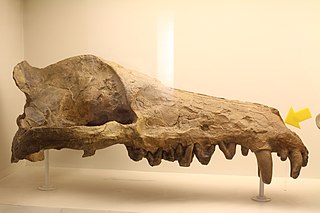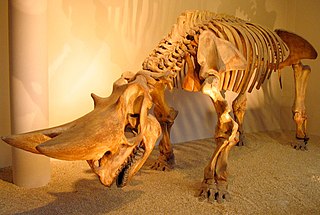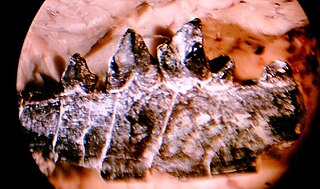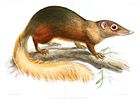
Cimolodonta is a clade of multituberculate mammals that lived from the Cretaceous to the Eocene. They probably lived something of a rodent-like existence until their ecological niche was assumed by true rodents. The more basal multituberculates are found in a different suborder, "Plagiaulacida", a paraphyletic group containing all non cimolodontan multituberculates.

Kryptobaatar, also known as Gobibaatar or Tugrigbaatar, is an extinct mammalian genus dating from the Upper Cretaceous Period and identified in Central Asia. This animal was a member of the extinct order of Multituberculata within the suborder Cimolodonta, and was a member of the family Djadochtatheriidae. It lived contemporaneously with some of the dinosaurs. Its skull had a length of perhaps 3 cm.
Mimetodon is a small mammal from the Paleocene of North America and perhaps Europe. It was a member of the extinct order Multituberculata within the suborder Cimolodonta and family Neoplagiaulacidae.

Andrewsarchus is an extinct genus of ungulate that lived during the Middle Eocene in China. It contains two species, A. mongoliensis and A. crassum. It was formerly placed in the families Mesonychidae or Arctocyonidae, but is now the sole member of a distinct family, Andrewsarchidae. Only known from a largely complete skull as well as isolated teeth, It is notable for being estimated as the largest terrestrial, carnivorous mammal, but that status has been disputed.

Simplicidentata is a group of mammals that includes the rodents and their closest extinct relatives. The term has historically been used as an alternative to Rodentia, contrasting the rodents with their close relatives the lagomorphs. However, Simplicidentata is now defined as including all members of Glires that share a more recent common ancestor with living rodents than with living lagomorphs. Thus, Simplicidentata is a total group that is more inclusive than Rodentia, a crown group that includes all living rodents, their last common ancestor, and all its descendants. Under this definition, the loss of the second pair of upper incisors is a synapomorphic feature of Simplicidentata. The loss of the second upper premolar (P2) has also been considered as synapomorphic for Simplicidentata, but the primitive simplicidentate Sinomylus does have a P2.

Embrithopoda ("heavy-footed") is an order of extinct mammals known from Asia, Africa and Eastern Europe. Most of the embrithopod genera are known exclusively from jaws and teeth dated from the late Paleocene to the late Eocene; however, the order is best known from its terminal member, the elephantine Arsinoitherium.

Cimolesta is an extinct order of non-placental eutherian mammals. Cimolestans had a wide variety of body shapes, dentition and lifestyles, though the majority of them were small to medium-sized general mammals that bore superficial resemblances to rodents, lagomorphs, mustelids, and marsupials.

Cimolestes is a genus of early eutherians with a full complement of teeth adapted for eating insects and other small animals. Paleontologists have disagreed on its relationship to other mammals, in part because quite different animals were assigned to the genus, making Cimolestes a grade taxon of animals with similar features rather than a genus of closely related ones. Fossils have been found in North America, South America, Europe and Africa. Cimolestes first appeared during the Late Cretaceous of North America. According to some paleontologists, Cimolestes died out at the start of the Paleocene, while others report the genus from the early Eocene.

Pachyaena was a genus of heavily built, relatively short-legged mesonychids, early Cenozoic mammals that evolved before the origin of either modern hoofed animals or carnivores, and combined characteristics similar to both. The genus likely originated from Asia and spread to Europe, and from there to North America across a land bridge in what is now the North Atlantic ocean. Various described species of Pachyaena ranged in size from a coyote to a bear. However, recent work indicates that Pachyaena is paraphyletic, with P. ossifraga being closer to Synoplotherium, Harpagolestes and Mesonyx than to P. gigantea.

Hapalodectidae is an extinct family of relatively small-bodied mesonychian placental mammals from the Paleocene and Eocene of North America and Asia. Hapalodectids differ from the larger and better-known mesonychids by having teeth specialized for cutting, while the teeth of other mesonychids, such as Mesonyx or Sinonyx, are more specialized for crushing bones. Hapalodectids were once considered a subfamily of the Mesonychidae, but the discovery of a skull of Hapalodectes hetangensis showed additional differences justifying placement in a distinct family. In particular, H. hetangensis has a postorbital bar closing the back of the orbit, a feature lacking in mesonychids. The skeleton of hapalodectids is poorly known, and of the postcranial elements, only the humerus has been described. The morphology of this bone indicates less specialization for terrestrial locomotion than in mesonychids.
Henricosborniidae is a family of extinct notoungulate mammals known from the Late Paleocene to Middle Eocene of Argentina, Bolivia and Brazil. The name honors U.S. paleontologist Henry Fairfield Osborn.

Notioprogonia is a suborder of the extinct mammalian order Notoungulata and includes two families, Henricosborniidae and Notostylopidae.

Ictidopappus is an extinct genus of mammals from extinct subfamily Ictidopappinae within extinct family Viverravidae, that lived in North America during the early Paleocene.

Anagaloidea is a former order of extinct placental mammals that first appeared during the Paleocene epoch.

Ernanodontidae is an extinct family of myrmecophagous placental mammals within extinct order Palaeanodonta, that lived in Asia from the middle to late Paleocene.

Pholidotamorpha is a clade of placental mammals from mirorder Ferae that includes the order Pholidota and extinct order Palaeanodonta.

Arctocyonians are a clade of laurasiatherian mammals whose stratigraphic range runs from the Palaeocene to the Early Eocene epochs. They were among the earliest examples of major mammalian predators after the Cretaceous–Paleogene extinction event. While some classify arctocyonians as stem-artiodactyls, others have classified the group as members of Ferae. There are three families classified in the order: Arctocyonidae, Oxyclaenidae, and Quettacyonidae.
Navajovius is an extinct genus of plesiadapiforms that lived during the Paleocene epoch. Plesiadapiforms were small, arboreal mammals that are theorized to be either closely related to primates or dermopterans. Navajovius has only been documented from localities within North America. This genus was officially named in 1921 by Walter Granger and William Matthew and the type specimen is housed at the American Museum of Natural History.

Eoastrapostylops is an extinct genus of astrapothere that lived during the Late Paleocene in what is now Argentina.




















